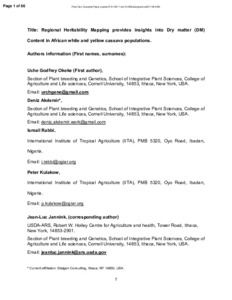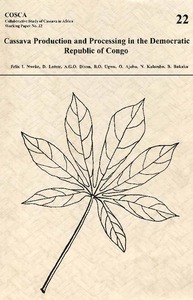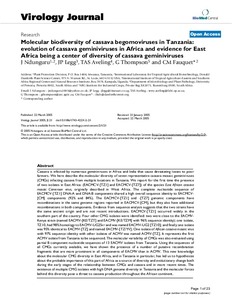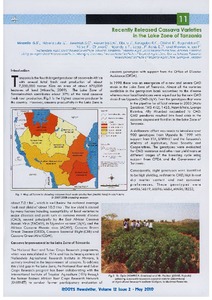| dc.contributor.author | Okeke, U.G. |
| dc.contributor.author | Akdemir, D. |
| dc.contributor.author | Rabbi, Ismail Y |
| dc.contributor.author | Kulakow, P.A. |
| dc.contributor.author | Jannink, Jean-Luc |
| dc.date.accessioned | 2019-12-04T11:11:19Z |
| dc.date.available | 2019-12-04T11:11:19Z |
| dc.date.issued | 2017 |
| dc.identifier.citation | Okeke, U.G., Akdemir, D., Rabbi, I., Kulakow, P. & Jannink, J.L. (2017). Regional Heritability Mapping provides insights into Dry matter (DM) Content in African white and yellow cassava populations. Plant Genome, 1-66. |
| dc.identifier.issn | 1940-3372 |
| dc.identifier.uri | https://hdl.handle.net/20.500.12478/2404 |
| dc.description | Article purchased |
| dc.description.abstract | The HarvestPlus program for cassava (Manihot esculenta Crantz) fortifies cassava with beta-carotene by breeding for carotene-rich tubers (yellow cassava). However, a negative correlation between yellowness and dry matter (DM) content has been
identified. Here, we investigated the genetic control of DM in white and yellow cassava subpopulations. We used regional heritability mapping (RHM) to associate DM to genomic segments in both subpopulations. Significant segments were subjected to
candidate gene analysis and we attempted to validate candidates using prediction accuracies. The RHM procedure was validated using a simulation approach. The RHM revealed significant hits for white cassava on chromosomes 1, 4, 5, 10, 17 and 18 while
hits for the yellow were on chromosome 1. Candidate gene analysis revealed genes in the carbohydrate biosynthesis pathway including the plant serine-threonine protein kinases (SnRKs), UDP-glycosyltransferases, UDP-sugar transporters, invertases,
pectinases, and regulons. Validation using 1252 unique identifiers from the SnRK gene family genome-wide recovered 50% of the predictive accuracy of whole genome SNPs for DM while validation using 53 likely (extracted from literature) genes from significant segments recovered 32%. Genes including an acid invertase, a neutral/alkaline invertase and a glucose-6-phosphate isomerase were validated based on an a priori list for the cassava starch pathway and also a fructose-biphosphate aldolase from the calvin cycle pathway. The power of the RHM procedure was estimated at 47 percent when the causal QTL generated 10% of the phenotypic variance with sample size of 451. Cassava DM genetics is complex. RHM may be useful for complex traits. |
| dc.description.sponsorship | Bill & Melinda Gates Foundation |
| dc.format.extent | 1-66 |
| dc.language.iso | en |
| dc.subject | Cassava |
| dc.subject | Gene |
| dc.subject | Cassava Starch |
| dc.subject | Regional Heritability Mapping |
| dc.subject | Dry Matter Content |
| dc.subject | Beta-Carotene |
| dc.subject | Yellow Cassava |
| dc.subject | White Cassava |
| dc.title | Regional Heritability Mapping provides insights into Dry matter (DM) Content in African white and yellow cassava populations |
| dc.type | Journal Article |
| dc.description.version | Peer Review |
| cg.contributor.crp | Roots, Tubers and Bananas |
| cg.contributor.affiliation | Cornell University |
| cg.contributor.affiliation | International Institute of Tropical Agriculture |
| cg.coverage.region | Africa |
| cg.coverage.region | West Africa |
| cg.coverage.country | Nigeria |
| cg.isijournal | ISI Journal |
| cg.authorship.types | CGIAR and advanced research institute |
| cg.iitasubject | Cassava |
| cg.iitasubject | Genetic Improvement |
| cg.iitasubject | Plant Genetic Resources |
| cg.journal | Plant Genome |
| cg.howpublished | Formally Published |
| cg.accessibilitystatus | Open Access |
| local.dspaceid | 92402 |
| cg.targetaudience | Scientists |
| cg.identifier.doi | http://dx.doi.org/10.3835/plantgenome2017.06.0050 |




